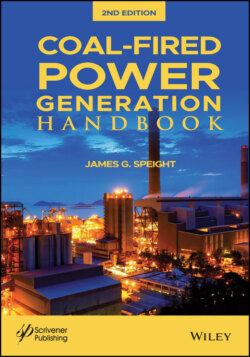Читать книгу Coal-Fired Power Generation Handbook - James Speight G., James G. Speight - Страница 104
4.4.3 Coal Size and Stockpile Ventilation
ОглавлениеOxidation increases with increasing fineness (decreasing size) of the coal pieces and the rate of oxidation of coal with oxygen of air is proportional to the specific internal surface (or external surface area). For the internal surface, the proportional coefficient at low temperatures is the cube root but analysis also shows that both rate and extent of oxidation increase with the decrease in particle size, until a critical particle diameter is reached, below which the rate remains fairly constant. For the external surface area, the surface area of a ton of half-inch particles is greater that the surface area of a ton of one-inch particles of coal.
The natural ventilation in coal storage piles is generally adequate to remove sensible heat as fast as it is liberated in the oxidation process. However, in situations where the ventilation is adequate to maintain oxidation but inadequate to dissipate the heat produced, the coal absorbs the heat, causing a rise in the internal temperature of the stockpile. A chain reaction follows in which the oxidation rate increases with increasing temperature and, if the temperature rise is allowed to proceed unchecked in the stockpile, the ignition temperature of the coal will eventually be reached and the stockpile will begin to burn. To an external observer, it will at first appear that the coal is smoldering die to emission of light barely visible smoke but in reality, the fire inside the stockpile may be vicious and vigorous.
Run-of-mine coal (ROM coal) is difficult to store because of the large percentages of fines mixed with the lump, of which some may be minerals that promote the oxidation and, thus, spontaneous ignition. On the other hand, there is usually less danger in storing lump coals that have been double-screened or closely sized. The uniform pieces of coal are honeycombed with passages through which air can circulate freely and carry off the heat generated. However, in stockpiles of coal fines sufficiently compacted so as to exclude air, the potential for spontaneous ignition is diminished. But it must be recognized that stockpiles of coal (whatever the size of the coal) are subject to some degree of oxidation and, when the auspices are correct, spontaneous ignition.
If coal is to be stored for prolonged periods of time, the pile should be constructed so that air (in the case of fine coal or mixed sizes such as run-of-mine coal) is excluded. On the other hand, if the coal is to be stored as lump coal, air should be allowed to circulate freely through the pile.
The total exposed surface area of the coal is of importance in that the more area exposed, the better the chance of oxygen interacting or reacting uniting with the coal and any heat liberated in a given time for a given weight of coal will be higher (Elder et al., 1945; Berkowitz and Speight, 1973).
When coal stockpiles are constructed by allowing mixed varied size coal to fall, roll, or slide, the larger pieces tend to collect at the bottom outside of the pile and the fines will collect at the top and inside of the stockpile. As a result, air will move easily through the outer parts of the stockpile but with much less freedom in the interior of the stockpile. Such a pile will allow the development of hot spots which can (or will) lead to spontaneous ignition of the coal with subsequent combustion of stockpile.
